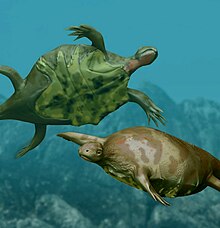Odontochelys
| Odontochelys | ||||||||||||
|---|---|---|---|---|---|---|---|---|---|---|---|---|

Fossil from Odontochelys |
||||||||||||
| Temporal occurrence | ||||||||||||
| Upper Triassic | ||||||||||||
| 220 million years | ||||||||||||
| Locations | ||||||||||||
|
||||||||||||
| Systematics | ||||||||||||
|
||||||||||||
| Scientific name | ||||||||||||
| Odontochelyidae | ||||||||||||
| Li et al. , 2008 | ||||||||||||
| Scientific name of the genus | ||||||||||||
| Odontochelys | ||||||||||||
| Li et al., 2008 | ||||||||||||
| Art | ||||||||||||
|
Odontochelys semitestacea > Li et al., 2008 |
||||||||||||
Odontochelys is an extinct genus of tortoises (Testudinata) from the Upper Triassic of China . So far only the type species O. semitestacea in the only genus of the taxon Odontochelyidae has been scientifically described . Until the discovery of Pappochelys , Odontochelys was considered the oldest and most original known member of the turtle tribe .
Naming
The name of the genus is derived from the Greek odonto- "tooth" and chelys "turtle", the type epithet from the Latin prefix semi - "half" and testaceus "armored". The name means something like "toothed turtle with half shell".
features
The type specimen is kept in the Institute of Vertebrate Paleontology and Paleoanthropology of the Chinese Academy of Sciences under archive number V 15639; the first description also referred to two other finds of the same type (IVPP V 13240 and IVPP V 15653).
The approximately 40 cm large fossil was discovered in the southwest Chinese province of Guizhou in about 220 million year old deposits of the coastal area of a sea from the Upper Triassic. In the first description it was referred to as particularly original with regard to the anatomy of the bony armor , as more original ("more primitive") also in comparison to the genus Proganochelys, which also comes from the Upper Triassic . In contrast to the turtles living today, the animal's upper and lower jaws were dentate. The belly armor (plastron) was fully developed, but not the back armor (carapace), only the ribs were already widened. From this, Li et al. 2008 that in the course of the turtle tribal history the belly-sided armor developed in front of the back armor. This sequence is consistent with the course of embryogenesis in today's tortoises.
Against this interpretation of the fossil evidence, Reisz et al. In 2008, however, concerns were raised parallel to the first description in the journal Nature . Based on the location on the edge of a sea or in a river delta, one could also argue that Odontochelys semitestacea already had a back armor, but - as with the recent sea softshell turtles - this was so little ossified that it was not preserved. This would mean that the lack of back armor in this species is not an original ( plesiomorphic ) feature, but rather a modification ( apomorphism ) compared to even older, hitherto unknown precursor species with hard back armor.
Web links
- Shell shocked. A fossil unearthed in China exhibits an incomplete shell that might explain how turtles evolved their protective armor. With a picture of the fossil. On: nature.com from December 3, 2008
Individual evidence
- ↑ according to a comment in Nature , Volume 456, 2008, p. XI
- ↑ Chun Li, Xiao-Chun Wu, Olivier Rieppel , Li-Ting Wang and Li-Jun Zhao: An ancestral turtle from the Late Triassic of southwestern China. In: Nature. Vol. 456, No. 7221, 2008, pp. 497-501, doi : 10.1038 / nature07533 .
- ^ Robert R. Reisz, Jason J. Head: Palaeontology: Turtle origins out to sea. In: Nature. Vol. 456, No. 7221, 2008, SS 450-451, doi : 10.1038 / 456450a .
